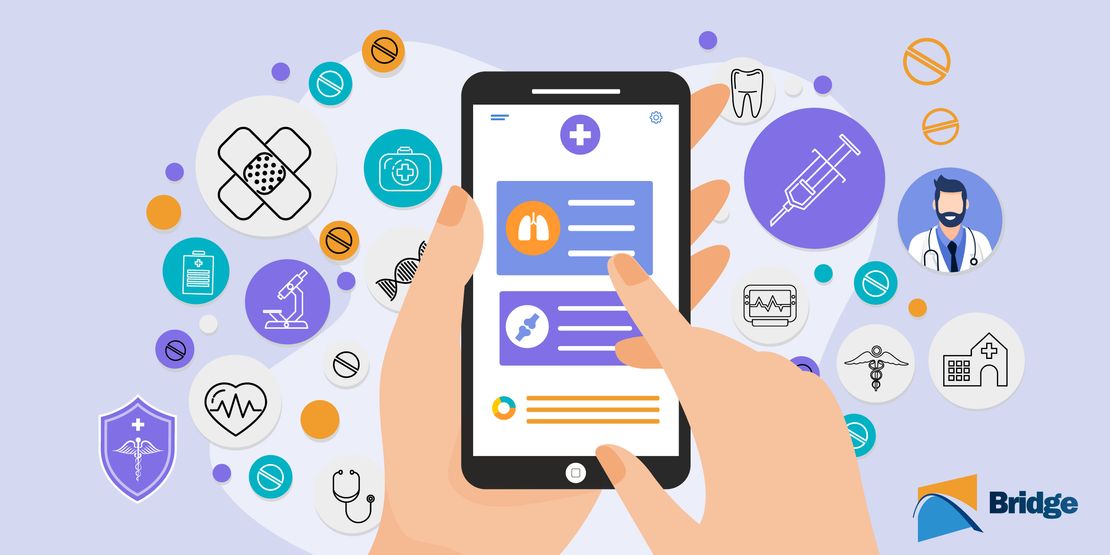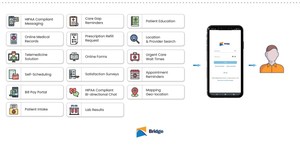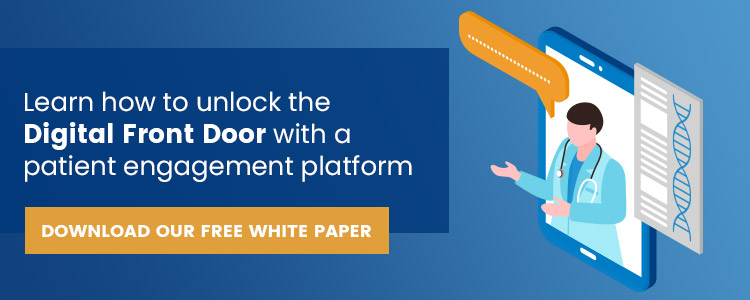How To Execute an Award-Winning Digital Front Door Strategy [2022]
- John Deutsch
- January 08, 2021

Updated on February 15, 2022
As patients expect more and more from their healthcare providers, especially when it comes to online services, medium to large-sized healthcare organizations are rapidly pushing to develop and execute their digital front door strategy. A digital front door should include features that promote patient autonomy and give users a seamless digital experience to ensure patient satisfaction. Below, we outline the digital features that patients expect from their healthcare providers and should be included in your digital front door strategy.
Provider / Location Search
Provide patients with a means to search for healthcare providers or healthcare organizations through the digital front door. Search results can include location, contact information, operating times, and wait times.
Appointment Scheduling
68%[¹] of patients are more likely to choose a healthcare provider that offers digital appointment self-scheduling. Medical appointment scheduling software allows the appointment scheduling process to be handled completely online. Patients can schedule appointments at any time, from a device of their choice, without having to call into your office and wait for an available staff member.
Patient Intake / Check-In
A patient intake solution allows patients to complete the intake process remotely on their chosen device. Patients can complete new enrollment forms, clinical history, consent, and insurance/billing before their consultation.
Patient Bill Pay
An online patient payment solution feature within a digital front door software allows patients to pay bills online and view their account details, including itemized costs. Online patient payment software provides more information than just the patient’s outstanding balance and can serve as a useful tool to offer patients payment options, such as payment plans, and therefore help them feel more capable of paying off their outstanding balance.
Mapping & Wayfinding
Geolocation tools provide patients with real-time guidance to help guide them and help them arrive at specific healthcare facilities or locations. Digital wayfinding helps patients navigate large healthcare facilities in a timely manner.
Patient Forms
Digital patient intake forms and questionnaires give patients the freedom to fill out forms remotely, on their chosen device, before their appointment, allowing for a more efficient intake process. Digital front door technology puts patient-entered information into the organization’s source system(s) to automatically populate registration, clinical history, screeners, consent, and insurance/billing discrete data fields in the organization’s EHR (Electronic Health Record) or PM (Practice Management) solution(s). Patient forms in a digital front door solution can also help advance Social Determinants of Health (SDoH) initiatives, thus improving patient outcomes.
Lab Results
Provide patients with a means to access their test/lab results in a HIPAA compliant manner with patient portal lab results. With patient portal lab results, lab results are sent to the patient portal either from the lab itself or the healthcare source systems. Here, patients can log in to view their results.
Patient-Provider Secure Messaging
69%[¹] of patients are more likely to choose a healthcare provider that offers bi-directional patient messaging. A HIPAA-secure messaging feature allows patients and caregivers to send and receive electronic messages with their healthcare providers, knowing that their personal health information is transmitted securely.
Remote Monitoring
53%[¹] of patients want their healthcare provider to implement remote patient monitoring software. Remote patient monitoring leverages devices that collect, combine, analyze, and report vital patient data from the comfort of the patient’s home.
Telemedicine
49%[¹] of patients are more likely to choose a healthcare provider that offers telemedicine. Telehealth, telemedicine, virtual visits, and related terms refer to exchanging medical information online through electronic communication, generally video.
Medical Records / Encounter Notes
Several healthcare authorities (ONC, CMS & HIPAA) enforce the fact that healthcare organizations should provide patients with electronic access to their health information. With a digital front door strategy, medical records portals allow patients to view their encounter notes and health records from their providers and combine health information from multiple sources, including user-entered data, into a single, consolidated patient record.
Patient Education
Patient-specific education materials are important tools for patient engagement and autonomy and in improving health outcomes. Some examples of patient-specific education materials include content relating to the patient’s diagnosis, an upcoming care visit, a past care visit, and general and ongoing health. With personalized patient education software, you can send education materials based on any variable you choose, such as medical condition, age, and type of upcoming or past appointment.
Live Chat
HIPAA compliant chat allows patients and providers to communicate about a patient’s condition, share lab results, and ask and answer questions in a HIPAA-compliant manner that keeps the patient’s information secure.
Urgent Care Visit Assistance
Urgent care visit assistance provides patients with important information regarding urgent care services, including up-to-date wait times and urgent care locations.
Prescription Refills
77%[¹] of patients want an automated prescription refill solution. Prescription refill request software allows patients to request medication refills online from anywhere, and at any time, from a device of their choice, without having to call their healthcare provider.
Health Maintenance Reminders
70%[¹] of patients want their healthcare provider to send automated patient appointment reminders. Patient appointment reminder software sends patients a follow-up reminder message regarding scheduled appointments and routine health maintenance and checkups. They can also be used to facilitate patient reactivation for patients who have not scheduled or attended an appointment for a long time.
Referral Requests
By adding a referral feature, patients can request a referral to an in-network specialist online. Integrating patient referral software into your digital front door means that medical records and notes can be shared seamlessly between providers.
Transportation Services
Transportation barriers are a major cause of missed appointments. With a transportation service option in the digital front door, providers can arrange patient transportation to and from facilities.
E-commerce
E-commerce is a digital front door feature in which healthcare services or products are displayed and can be purchased online with the use of a credit card. An example of such a service could be a telehealth visit bundle that includes remote monitoring and wellness devices.
Insurance Eligibility & Service Estimates
A digital front door strategy allows for automated verification of insurance coverage without the need for staff assistance. An equipped patient portal, such as Bridge Patient Portal, works with a real-time EDI service for insurance eligibility and cost estimations, typically performed during the patient intake/web check-in process and can include price estimates overtime for extended treatment courses.
Virtual Waiting Room
A virtual waiting room gives patients the means to complete the intake process from their mobile or desktop device without the need to step foot into the practice or to “check-in” to a virtual visit. A virtual waiting room includes features like queue system, self-check-in, and online intake forms.
Are You Ready to Lead Your Healthcare Organization into the Future?
More than half[¹] of patients expect their practitioners to provide digital capabilities that facilitate patient autonomy. Failure to provide such a solution can result in a loss of patients and, consequently, revenue. However, developing a comprehensive digital front door strategy is no small feat. That is why many healthcare organizations partner with industry-leading patient engagement providers, such as Bridge Patient Portal. If you’re ready to lead your healthcare organization into the future, contact us to discuss our innovative digital front door software.
- Accenture. (2019). Today’s Consumers Reveal the Future of Healthcare. [online] accenture.com. Available at:https://www.accenture.com/us-en/insights/health/todays-consumers-reveal-future-healthcare.

